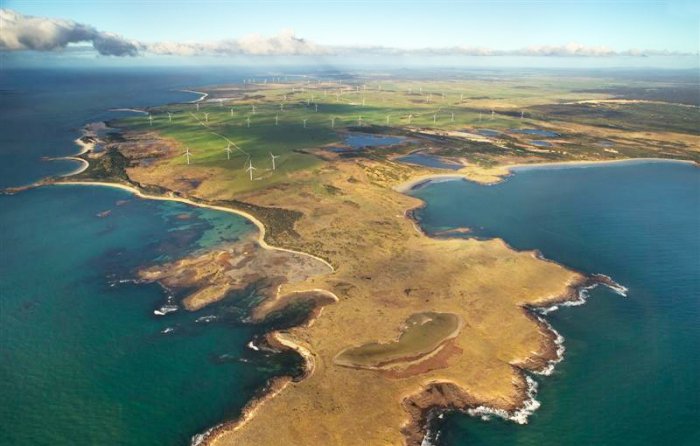The Liberals’ own Renewable Energy Target is looking very shaky. Will this be the last domino to fall? [25 February 2014 | Peter Boyer]

Musselroe wind farm in NE Tasmania. PHOTO HYDRO TASMANIA
One by one, the jigsaw pieces are falling into place. Tony Abbott’s radical plan to reverse Australia’s steady shift to renewable energy becomes clearer with each passing week.
The biggest development so far in this unveiling came last week with the announcement of the four-person team, headed by company chairman Dick Warburton, to conduct a special review of Australia’s Renewable Energy Target (RET) scheme.
Laws enacted by the Gillard government give the Climate Change Authority under Bernie Fraser statutory responsibility for two-yearly reviews of the RET. Tony Abbott doesn’t want to hear from the Authority, which he plans to abolish, so he’s doing his own review.
This promises to move the ground under the climate-energy debate in this country more than anything else in the short, interesting history of the Abbott government. I’ll explain why, but first some history.
The RET wasn’t created by a government under Julia Gillard or Kevin Rudd, but by the second Howard government way back in April 2001. Environment minister Greg Hunt has expressed pride in this achievement, often comparing it favourably to Labor’s “ineffectual” carbon tax.
It was set up to increase demand for generation of renewable energy. It works by effectively requiring wholesale buyers of electricity to get a fixed amount of their power from renewable sources, through the mechanism of surrendering tradeable renewable energy certificates.
Its initial target was for a modest 9500 gigawatt-hours of renewable energy by 2010. In 2009 the Rudd government went for a percentage target: 20 per cent of Australia’s energy by 2020.
Julia Gillard’s government reinstated a fixed-figure target of 41,000 gigawatt-hours per year from 2020, which has fostered expanding windpower and a huge uptake of rooftop solar. It’s this that now has the fossil electricity industry so steamed up.
Falling electricity demand means that by 2020 renewable energy may make up as much as 30 per cent of the total. I think that’s a very good thing, but some big energy players certainly don’t.
The scheme is scheduled to end in 2030 under legislation passed in 2011. At the time it was envisaged that emissions trading would render it unnecessary after 2030. Under Australia’s current carbon pricing laws, today’s fixed price scheme shifts to emissions trading in 2015.
But the Abbott government intends to ditch Labor’s climate measures, including carbon pricing, and replace them with its own “Direct Action” package, which would change the game completely.
Australia’s emission-mitigation arsenal would then comprise a poorly-understood, much-criticised Emissions Reduction Fund (ERF), Hunt’s even less-understood plant and soil carbon plan which science indicates will take decades to have any real effect, and the existing, well-understood RET.
Given all this, you’d think that of all Australia’s remaining climate and energy measures, the RET would be safe from the chop. This is backed up by Hunt, who as recently as last week gave an assurance that the RET would be kept, with its 20 per cent by 2020 target intact.
But signs are very troubling. Pre-election promises to support the Australian Renewable Energy Agency (ARENA), charged with increasing competitiveness and fostering takeup of renewables, were put aside in November when the government cut ARENA funding by $435 million.
Whatever remains of government resolve to support the RET now faces its sternest test, as a determined coal and gas industry ratchets up its effort to shove it out the door.
The campaign is already getting traction in the government party rooms. Its most trenchant parliamentary critic has been veteran Queensland Nationals senator, Ron Boswell, who claims the RET in its present form will cost Australia billions of dollars by 2020.
Maurice Newman, chair of Abbott’s Business Advisory Council, has worked for years to have the RET scrapped on grounds that the science is wrong and renewable energy pushes up power prices. Abbott’s only recent comment about the RET was that it raised power prices.
In January The Australian’s Graham Lloyd cited a “senior government figure” saying that Hunt and industry minister Ian Macfarlane were the only cabinet members actively supporting the scheme.
The review panel announced by Hunt and Macfarlane left no doubt who won the debate in cabinet, and it wasn’t the two ministers fronting the cameras.
One of the panel’s four members is Matt Zema, CEO of the Australian Electricity Market Operator, who has in the past supported a strong renewable energy sector. But it’s hard to see any such support coming from the other three.
Brian Fisher, lobbyist and former head of the Australian Bureau of Agricultural and Resource Economics (ABARE), has long been an opponent of any market intervention, and Shirley In’t Veld once headed up the WA company Verve Energy, which deals almost exclusively in fossil energy.
Heading the review is Dick Warburton, chairman of several companies including Westfield Retail Trust and a declared sceptic about human-induced warming. He led a concerted industry campaign against the Gillard government’s pricing scheme.
It’s looking more than likely that the review will spell out why the RET should be scrapped or at least emasculated. With repeal of Clean Energy Future laws, the untried Emissions Reduction Fund would then be our sole weapon at the national level against rising emissions.
With strict limits on ERF funding and many unanswered questions about how it will work, Hunt’s climate policies seem on the verge of collapsing in a heap. This is looking like a demolition job.
On Thursday, candidates contesting the State election, including MPs Matthew Groom and Cassy O’Connor, will debate their parties’ climate policies in a public forum organised by Climate Action Hobart, at Wesley Hall, 58 Melville Street, Hobart, starting at 7.30 pm.
